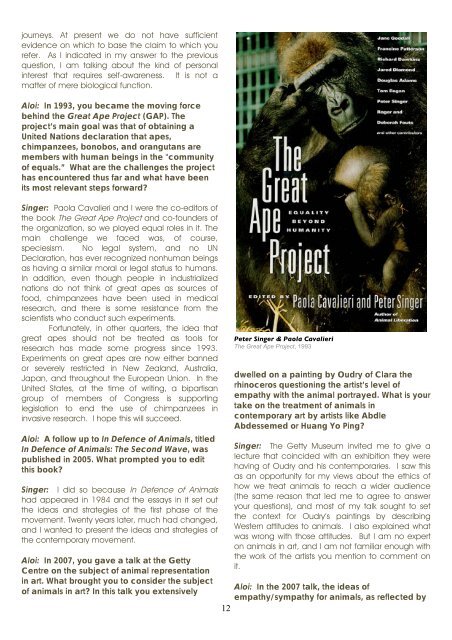Animal Wrongs and Rights - Antennae The Journal of Nature in ...
Animal Wrongs and Rights - Antennae The Journal of Nature in ...
Animal Wrongs and Rights - Antennae The Journal of Nature in ...
You also want an ePaper? Increase the reach of your titles
YUMPU automatically turns print PDFs into web optimized ePapers that Google loves.
journeys. At present we do not have sufficient<br />
evidence on which to base the claim to which you<br />
refer. As I <strong>in</strong>dicated <strong>in</strong> my answer to the previous<br />
question, I am talk<strong>in</strong>g about the k<strong>in</strong>d <strong>of</strong> personal<br />
<strong>in</strong>terest that requires self-awareness. It is not a<br />
matter <strong>of</strong> mere biological function.<br />
Aloi: In 1993, you became the mov<strong>in</strong>g force<br />
beh<strong>in</strong>d the Great Ape Project (GAP). <strong>The</strong><br />
project’s ma<strong>in</strong> goal was that <strong>of</strong> obta<strong>in</strong><strong>in</strong>g a<br />
United Nations declaration that apes,<br />
chimpanzees, bonobos, <strong>and</strong> orangutans are<br />
members with human be<strong>in</strong>gs <strong>in</strong> the "community<br />
<strong>of</strong> equals.” What are the challenges the project<br />
has encountered thus far <strong>and</strong> what have been<br />
its most relevant steps forward?<br />
S<strong>in</strong>ger: Paola Cavalieri <strong>and</strong> I were the co-editors <strong>of</strong><br />
the book <strong>The</strong> Great Ape Project <strong>and</strong> co-founders <strong>of</strong><br />
the organization, so we played equal roles <strong>in</strong> it. <strong>The</strong><br />
ma<strong>in</strong> challenge we faced was, <strong>of</strong> course,<br />
speciesism. No legal system, <strong>and</strong> no UN<br />
Declaration, has ever recognized nonhuman be<strong>in</strong>gs<br />
as hav<strong>in</strong>g a similar moral or legal status to humans.<br />
In addition, even though people <strong>in</strong> <strong>in</strong>dustrialized<br />
nations do not th<strong>in</strong>k <strong>of</strong> great apes as sources <strong>of</strong><br />
food, chimpanzees have been used <strong>in</strong> medical<br />
research, <strong>and</strong> there is some resistance from the<br />
scientists who conduct such experiments.<br />
Fortunately, <strong>in</strong> other quarters, the idea that<br />
great apes should not be treated as tools for<br />
research has made some progress s<strong>in</strong>ce 1993.<br />
Experiments on great apes are now either banned<br />
or severely restricted <strong>in</strong> New Zeal<strong>and</strong>, Australia,<br />
Japan, <strong>and</strong> throughout the European Union. In the<br />
United States, at the time <strong>of</strong> writ<strong>in</strong>g, a bipartisan<br />
group <strong>of</strong> members <strong>of</strong> Congress is support<strong>in</strong>g<br />
legislation to end the use <strong>of</strong> chimpanzees <strong>in</strong><br />
<strong>in</strong>vasive research. I hope this will succeed.<br />
Aloi: A follow up to In Defence <strong>of</strong> <strong>Animal</strong>s, titled<br />
In Defence <strong>of</strong> <strong>Animal</strong>s: <strong>The</strong> Second Wave, was<br />
published <strong>in</strong> 2005. What prompted you to edit<br />
this book?<br />
S<strong>in</strong>ger: I did so because In Defence <strong>of</strong> <strong>Animal</strong>s<br />
had appeared <strong>in</strong> 1984 <strong>and</strong> the essays <strong>in</strong> it set out<br />
the ideas <strong>and</strong> strategies <strong>of</strong> the first phase <strong>of</strong> the<br />
movement. Twenty years later, much had changed,<br />
<strong>and</strong> I wanted to present the ideas <strong>and</strong> strategies <strong>of</strong><br />
the contemporary movement.<br />
Aloi: In 2007, you gave a talk at the Getty<br />
Centre on the subject <strong>of</strong> animal representation<br />
<strong>in</strong> art. What brought you to consider the subject<br />
<strong>of</strong> animals <strong>in</strong> art? In this talk you extensively<br />
12<br />
Peter S<strong>in</strong>ger & Paola Cavalieri<br />
<strong>The</strong> Great Ape Project, 1993<br />
dwelled on a pa<strong>in</strong>t<strong>in</strong>g by Oudry <strong>of</strong> Clara the<br />
rh<strong>in</strong>oceros question<strong>in</strong>g the artist’s level <strong>of</strong><br />
empathy with the animal portrayed. What is your<br />
take on the treatment <strong>of</strong> animals <strong>in</strong><br />
contemporary art by artists like Abdle<br />
Abdessemed or Huang Yo P<strong>in</strong>g?<br />
S<strong>in</strong>ger: <strong>The</strong> Getty Museum <strong>in</strong>vited me to give a<br />
lecture that co<strong>in</strong>cided with an exhibition they were<br />
hav<strong>in</strong>g <strong>of</strong> Oudry <strong>and</strong> his contemporaries. I saw this<br />
as an opportunity for my views about the ethics <strong>of</strong><br />
how we treat animals to reach a wider audience<br />
(the same reason that led me to agree to answer<br />
your questions), <strong>and</strong> most <strong>of</strong> my talk sought to set<br />
the context for Oudry’s pa<strong>in</strong>t<strong>in</strong>gs by describ<strong>in</strong>g<br />
Western attitudes to animals. I also expla<strong>in</strong>ed what<br />
was wrong with those attitudes. But I am no expert<br />
on animals <strong>in</strong> art, <strong>and</strong> I am not familiar enough with<br />
the work <strong>of</strong> the artists you mention to comment on<br />
it.<br />
Aloi: In the 2007 talk, the ideas <strong>of</strong><br />
empathy/sympathy for animals, as reflected by












